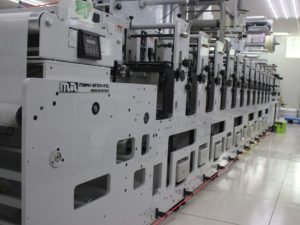Suzhou Advanced Printing (‘Suzhou Advanced’) is one of the fastest growing converters in the Chinese label printing industry.

From the establishment of its factory in 2001, the company has grown steadily. In 2008, the first Mark Andy flexo press was installed, with on average one new press added each year after that. Today Suzhou Advanced has six Mark Andy flexo presses and annual sales of RMB 150million Yuan (24.5 million US dollars). This makes the company one of the top professional self-adhesive label converters in East China, and brings them a powerful competitive edge in such fields as household chemicals, pharmacy and foods, with well-known customers from both inside China and abroad.
Besides the advantage of its location, a key reason for the success of Suzhou Advanced is a focus on technology and innovation. Zhong Xiaochun is vice general manager and chief engineer at Suzhou Advanced. He says that what differentiates the top converters in China today is not so much the equipment, which is widely available, but the level of management expertise.
To reduce energy consumption is a key focus for Suzhou Advanced, which uses UV curing on all its flexo presses.
In fact, we have been searching for new UV curing technology for a few years,’ says Zhong Xiaochun, ‘At the time of the installation of the first Mark Andy press, we specified a GEW VCP UV curing system. At that time, we made a comparison between this and the domestically supplied UV lamps we used before. Our energy consumption was reduced by 20 percent, and the curing effect and stability met all our expectations.’ Suzhou Advanced installed VCP lamps on every flexo press it installed. Explained Mr. Zhong, ‘After so many years of cooperation with GEW, we have got a lot of benefits, and what’s more important, we obtained mutual trust.’
So when Tekey Zhang, technical general manager of Chinese GEW representative Shanghai LongShine Printing Tech, recommended GEW’s latest E2C curing technology, the company installed a trial system on its new Mark Andy 2200 flexo press in the second half of last year. Advanced technicians undertook detailed comparisons with an existing VCP-equipped Mark Andy 2200. Both are configured with eight color stations.
Mr. Zhong showed L&L the test results: ‘At the same printing speed, the total energy consumed by the E2C UV system was 13.05KW, which is far below the total power of 32.34KW consumed by the old VCP system. The result was far beyond of our expectation.’
COLLATERAL REVENUE
The tests showed the E2C lamps achieve the same curing power as the VCP lamps with only 36 percent of the power. Equal curing power with reduced energy consumption means the service life of the E2C UV lamp should be significantly extended. ‘The E2C lamps have been running for more than 2,000 hours so far, indicating the huge improvement when compared with the VCP UV lamp, which we could use for only 1,500 hours or so,’ said Mr. Zhong.
Tekey Zhang added that GEW’s European customers have seen EC2 lamps last 2,700 hours or more.
The improved curing efficiency of the new E2C lamp and reflector design meant press operators were more confident in running the press faster. Added Tekey Zhang, ‘At the end of last year, we presented a demonstration of the E2C curing system on an Omet press at their Suzhou plant, and at a speed of 180m/min, the curing was sound.’
Another advantage of the new lamps for Advanced is shortened shutdown and maintenance time – with consequently improved production efficiency and reduced labor waste.
In addition, the lower temperature output of the E2C system means less heat and CO2 discharge. Although the Chinese government has not put explicit restrictions on carbon discharge and power consumption in printing factories, Suzhou Advanced puts a high value on behaving as a responsible, sustainable social enterprise.

